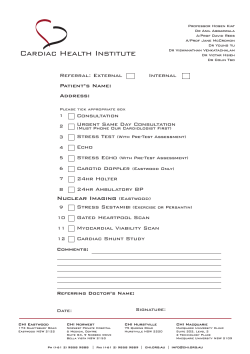
Cymraeg
28 Chwefror 2012 In Wales, this is like Canada Day here Dydd Iau, 1af Mawrth Thursday, Ist March The CLT 1120 class is invited to a St David’s Day reception this Thursday at 5:30pm. You have to RSVP to ukincanada@fco.gov.uk It’s informal. The British High Commission, 80 Elgin Street. Remember RSVP is essential. Those who are studying CLT 2155 and CLT1120 (both) have permission to attend the reception if they wish. (CLT 2155 is held at the same time as the reception). Cofiwch.... Remember..... If you would like to come, you must RSVP by today at the latest. Just say you will be coming to the Welsh reception on 1st March. ukincanada@fco.gov.uk A chance to meet Welsh-speakers. The nineth procession will take place in Cardiff on 1st March. Huw Edwards presents ‘The Story of Wales: The Makings of Wales’ http://www.bbc.co.uk/programmes/p00pk3hv Mae gen i gar. Oes gynnoch chi gar? Does gen i ddim car Ymarfer tud 48 Oes/ nac oes Dw i- I am (this can go at the beginning of a sentence or at the endDw i’n oer; dw i wedi blino; Sandra dw i= I am cold, I’m tired, I’m Sandra. Dw i’n dysgu Cymraeg- I’m learning Welsh; dw i’n mynd i Toronto- I’m going to Toronto. Mae means basically ‘is’ or ‘there is’. It usually only goes at the beginning of a sentence: Mae hi’n gynnes heddiw- It’s warm today Mae hi’n bwrw eira- It’s snowing Mae Sandra wedi blino- Sandra’s tired. Mae o’n dysgu Ffrangeg- he’s learning French. Ydy can come at the beginning of a sentence as a question: Ydy hi’n bwrw glaw-Is it raining? Ydy Dewi yn mynd i Montreal? –Is Dewi going to Montreal? When it stands alone, it is the answer ‘yes’ to a question that uses ‘ydy’. Ydy hi’n wyntog? Ydy. Is it windy? Yes. Ydy can also come in the middle of a sentence when there is a bit of emphasis on another word (eg a name, proffession, natioality) Cymro ydy John- John is a Welshman Deintyddes ydy Sandra-Sandra is a dentist Risiart ydy o- he’s Richard. These sentences can also be questions. Dewi ydy o? Is he Dewi? Oes usually occurs at the beginning of a sentence and also means ‘is’ and ‘yes’. Often at the beginning of a sentence it means ‘is there...’? It cannot be followed by ‘y’ meaning ‘the’. Oes bara yn yr oergell? Is there (any) bread in the fridge? Oes digon o amser? Is there enough time. Standing alone, oes means ‘yes’ but only to a question that uses oes. Oes heddwch? Oes. When these forms are negative (ie- is not etc), their form changes: Mae becomes dydy (when followed by a noun or pronoun) and also brings in another word ddim which marks the negative, compare French ne...pas: Dydy hi ddim yn oer heddiw- It isn’t cold today Dydy John ddim yn medru siarad CymraegJohn is not able to speak Welsh With sentences like ‘Cymro ydy John’, the negative is formed differently, the word ‘nid’ comes first: Nid Cymro ydy John. (In regional Welsh, you will find forms like ‘nage Cymro ydy John’) Athrawes ydy Sandra? Nage, nid athrawes ydy hi, ond gwraig fusnes. When mae has no noun or pronoun (hi, o, a person’s name or the word for ‘the’ y/yr/’r) after it, the negative is not dydy but does dim. Mae bara yn yr oergell- there is bread in the fridge. Does dim bara yn yr oergell- there isn’t any bread in the fridge. Oes is used a lot in the construction in Welsh that corresponds to the verb ‘to have’ (possession) in English, and avoir in French (but in the construction of tenses). Mae gen i un ci (ddau gi) Mae gen i un gath (ddwy gath) Mae gynnon ni ddwy gath Oes gynnoch chi ffôn symudol? Oes/nac oes Faint o blant/gathod sy gynnoch chi? Mae gynno fo gi/gath/gar/frawd/chwaer Mae gynni hi feic newydd/broblem/lawer o bres. Mae gynnyn nhw ddau gi gwyn Mae gynnyn nhw dri hogyn/dair hogan Oes gynno fo lawer o waith cartre? (Nac oes!) Oes gynni hi frawd? (Oes!) Oes gynnyn nhw anifeiliaid? (Nac oes) Being negative about it all….a variation on does dim. Does gen i ddim amser sbâr. Does gynni hi ddim gwaith cartre heno Does gynno fo ddim llawer o amser Oes gen ti ddiddordebau (interests)? Oes, dw i’n hoffi ……….. Faint o blant sy gynnoch chi? Tudalen 57 (pum deg saith) Cwestiwn ac ateb. Dw i (I am) Dw i’n mynd (I am going) Rwyt ti Rwyt ti’n mynd Dan ni Dan ni’n mynd Dach chi Dach chi’n mynd Maen nhw Maen nhw’n mynd affirmative Dw i ddim (I am not) Dw i ddim yn mynd( I am not going) Dwyt ti ddim Dwyt ti ddim yn mynd Dan ni ddim Dan ni ddim yn mynd Dach chi ddim Dach chi ddim yn mynd Dydyn nhw Dydyn nhw ddim yn mynd negative Dw i (I am) Dw i’n mynd (I am going) Rwyt ti Rwyt ti’n mynd Dan ni Dan ni’n mynd Dach chi Dach chi’n mynd Maen nhw Maen nhw’n mynd affirmative Ydw i? (Am I) Ydw i’n mynd? Wyt ti? (Are you?) Wyt ti’n mynd? Dan ni? (Are we?) Dan ni’n mynd? Dach chi? (Are you?) Dach chi’n mynd? Ydyn nhw? (are they?) Ydyn nhw’n mynd? Question form/Interrogative Mae hi’n oer Mae hi’n rhy oer! Mae/mi fydd/ roedd hi’n wyntog! Mae /mi fydd/ roedd hi’n bwrw eira. Be ‘ydy’ch enw chi? Dafydd/Mair dach chi? O le dach chi’n dwad/dod? (yn wreiddiol) Lle dach chi’n byw? Be’ dach chi’n wneud? Lle dach chi’n gweithio? Sut dach chi? Pwy ydy o/hi? Be’ydy ei enw o/ ei henw hi? Dafydd ydy o? Mair ydy hi? Brawd pwy ydy o? Chwaer pwy ydy hi? Be ‘ mae o’n wneud? Be’ mae hi’n wneud? Lle mae o’n byw? Lle mae hi’n byw? Ydy o’n byw yn X? ydy hi’n byw yn X? Ydy o’n/hi’n gweithio fel trydanwr? Dw i’n mynd i gael cinio Lle mae hi’n mynd? Mae hi’n mynd i’r pwll nofio. Lle mae o’n mynd? Mae o’n mynd i’r gwely.
© Copyright 2025









